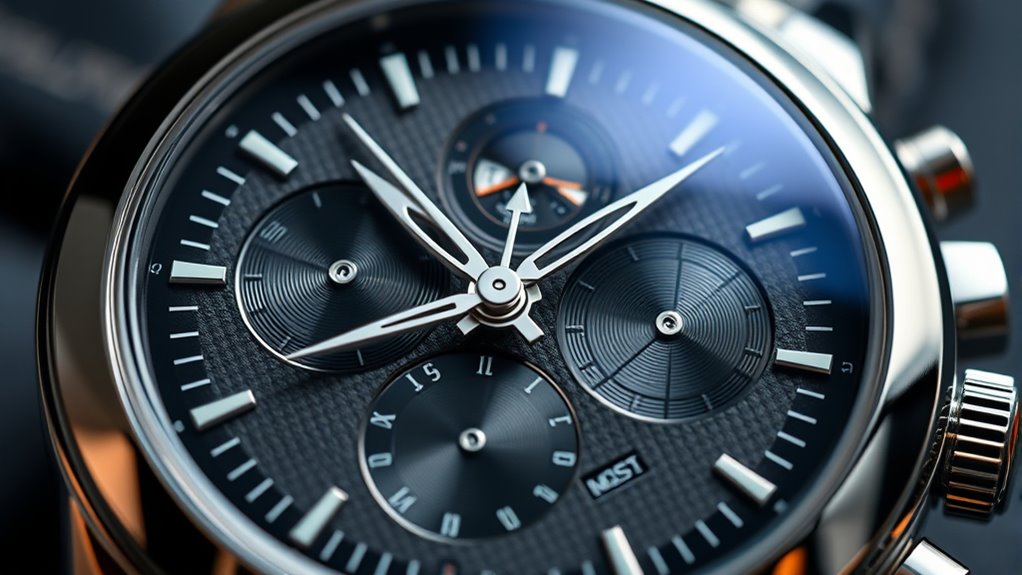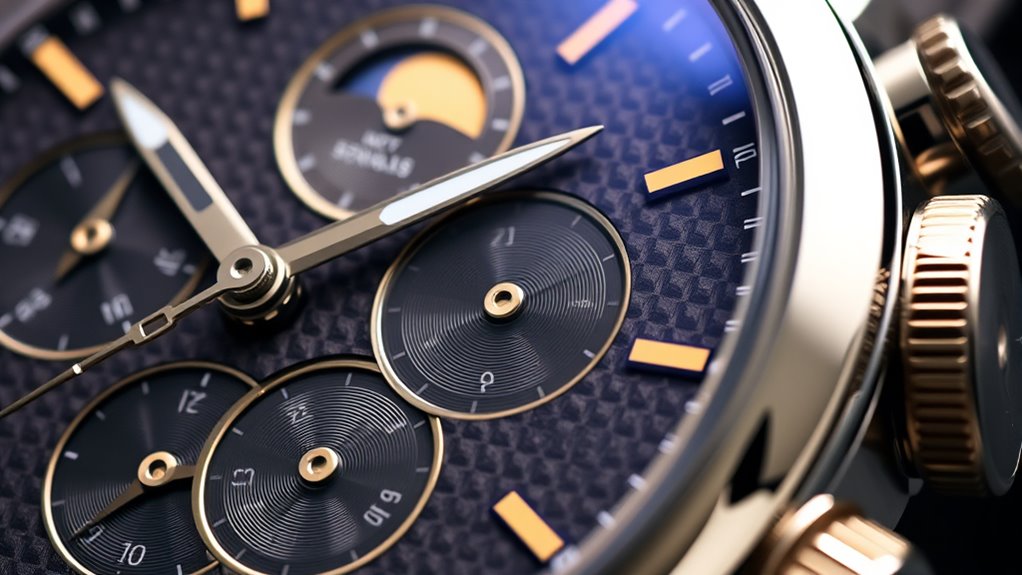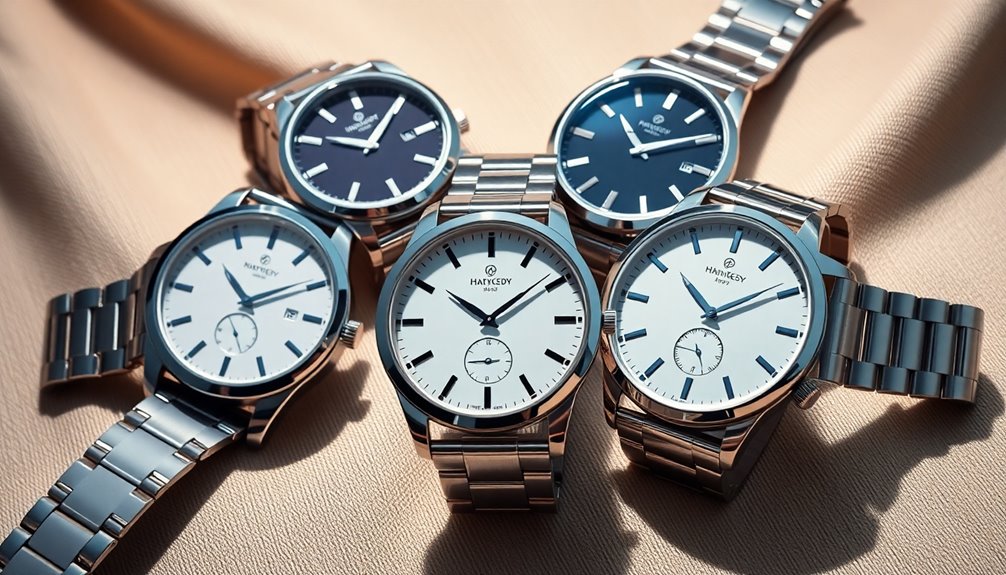A guide to watch complications shows you how these features go beyond just telling the time. They add functionality like chronographs for precise timing, calendars that adjust for leap years, and tourbillons to improve accuracy by counteracting gravity. These intricate features showcase the craftsmanship and innovation behind high-end watches. If you’re curious about the fascinating world of horology, exploring further reveals how these complications transform a simple watch into a sophisticated masterpiece.
Key Takeaways
- Watch complications add features like chronographs, calendars, and tourbillons, enhancing both functionality and horological artistry.
- Chronographs serve as precise stopwatches, ideal for timing sports and events, showcasing advanced movement mechanics.
- Calendar complications, from simple date displays to perpetual calendars, provide detailed timekeeping information without external devices.
- Tourbillons counteract gravity’s effects on accuracy, representing high-end craftsmanship and engineering mastery in watchmaking.
- Technological advances improve complication reliability and precision, transforming watches into intricate works of art and engineering marvels.

Watch complications are additional features that enhance a timepiece’s functionality and complexity beyond simply telling time. When you look at a watch with complications, you’re not just seeing hours, minutes, and seconds; you’re witnessing a marvel of horological ingenuity. These watch functions serve specific purposes, often rooted in practical needs or aesthetic preferences, and they showcase the craftsmanship behind each watch. By understanding horological features, you’ll appreciate how these complications transform a simple watch into a sophisticated instrument.
One of the most common watch functions you’ll encounter is the chronograph. It acts like a stopwatch, allowing you to time events with precision. This complication typically involves extra pushers on the side of the case, which start, stop, and reset the timing mechanism. When you activate the chronograph, you’re engaging a separate gear train that records elapsed time, making it invaluable for sports, racing, or any activity requiring accurate measurement. The chronograph is a perfect example of how watch functions extend beyond basic timekeeping, adding practical utility to your watch.
A chronograph acts as a stopwatch, providing precise timing for sports, racing, and other activities requiring accuracy.
Another popular horological feature is the calendar complication, which can be as simple as a date window or as complex as a perpetual calendar that adjusts for leap years. These watch functions keep you informed about the date without needing to consult a calendar, blending convenience with technical mastery. Some watches even feature day, month, and moon phase indicators, giving you a full picture of the calendar cycle at a glance. These features demonstrate how watchmakers have integrated additional layers of information into a compact display, making your watch a miniature calendar on your wrist.
Tourbillons are another remarkable horological feature, designed to counteract the effects of gravity on the watch’s movement. They consist of a rotating cage that holds the escapement and balance wheel, constantly changing their position to improve accuracy. While not as common due to their complexity and cost, tourbillons exemplify high horology and the pursuit of precision. When you see a watch with a tourbillon, you’re witnessing a pinnacle of watch functions that combines engineering mastery with aesthetic appeal.
Additionally, advancements in movement technology have allowed for more precise and reliable complications, further enhancing the performance of sophisticated timepieces. In essence, watch complications and horological features demonstrate a universe of possibilities within a single timepiece. They serve as a testament to the skill and innovation of watchmakers, transforming a device that merely tells time into a work of art and engineering. Whether it’s a chronograph, calendar, or tourbillon, these watch functions elevate your experience, making every glance at your wrist a moment of admiration for the intricate craft behind it.
Frequently Asked Questions
How Do Watch Complications Affect Maintenance Costs?
Watch complications can increase your maintenance costs because they make watch repair and complication servicing more complex. The additional features require extra attention, specialized tools, and skilled watchmakers, which can raise service fees. You should expect higher costs when servicing watches with multiple complications, as they demand more precise adjustments and careful handling. Regular maintenance becomes even more important to keep your watch functioning smoothly and avoid costly repairs later.
Are Complications More Common in Luxury or Budget Watches?
You’ll find complications are more common in luxury watches, reflecting their rich watch complication history and intricate complication design trends. These features showcase craftsmanship and sophistication, appealing to collectors and enthusiasts. Budget watches tend to focus on basic time-telling functions, with fewer complications. As watchmaking evolves, luxury brands continue to innovate with complex features, making complications a hallmark of high-end timepieces, whereas budget models prioritize simplicity and affordability.
Can Complications Be Added to Existing Watches?
You can definitely add complications to existing watches through watch modification and complication customization. Many watchmakers and specialists offer services to enhance your current timepiece with features like moon phases or chronographs. Keep in mind, though, that not all watches are suitable for modifications, especially vintage or delicate models. It’s best to consult a professional to make sure your watch can handle the added complications without compromising its integrity.
What Is the Most Complex Watch Complication Ever Created?
You’re curious about the most complex watch complication ever created. It’s the Patek Philippe Henry Graves Supercomplication, a masterpiece born from horological innovations and historical developments. This intricate pocket watch features 24 complications, including a celestial chart, perpetual calendar, and minute repeater. Its incredible craftsmanship and engineering push the boundaries of watchmaking, showcasing how horological innovations continue to evolve, making it one of the most celebrated and complex timepieces in history.
Do Complications Impact the Watch’s Accuracy?
Complications can impact your watch’s accuracy concerns, as added features may introduce complexity that affects complication precision. When a watch has multiple complications, it requires more intricate mechanisms, which can sometimes lead to slight timing deviations. However, high-quality watches are designed to mitigate these effects. So, while complications might influence accuracy, top-tier craftsmanship ensures your watch remains reliable and precise despite the added features.
Conclusion
Now that you know about watch complications, you’re like a navigator charting a course through a sea of intricate gears and tiny marvels. These features turn a simple timepiece into a symphony of craftsmanship, each complication a note in a grand melody. So, next time you glance at your watch, remember it’s more than just telling time—it’s a story etched in miniature, waiting for you to discover its hidden treasures and reveal its secrets.









